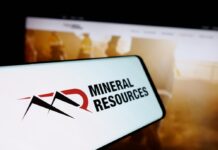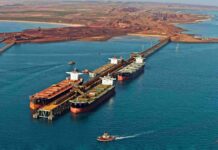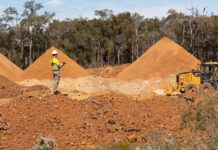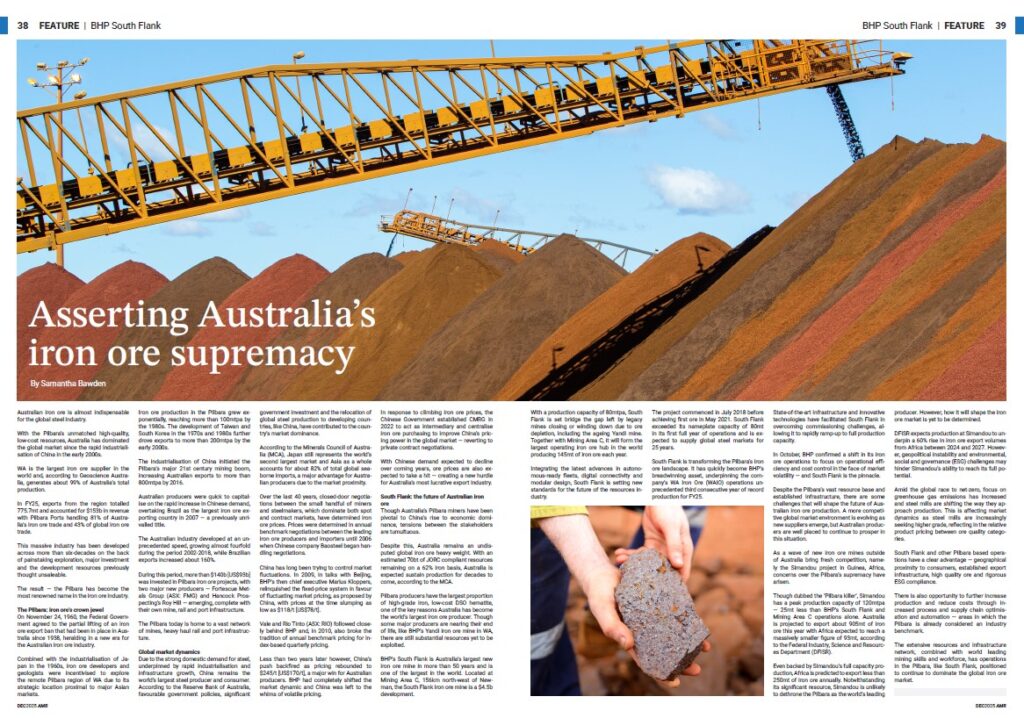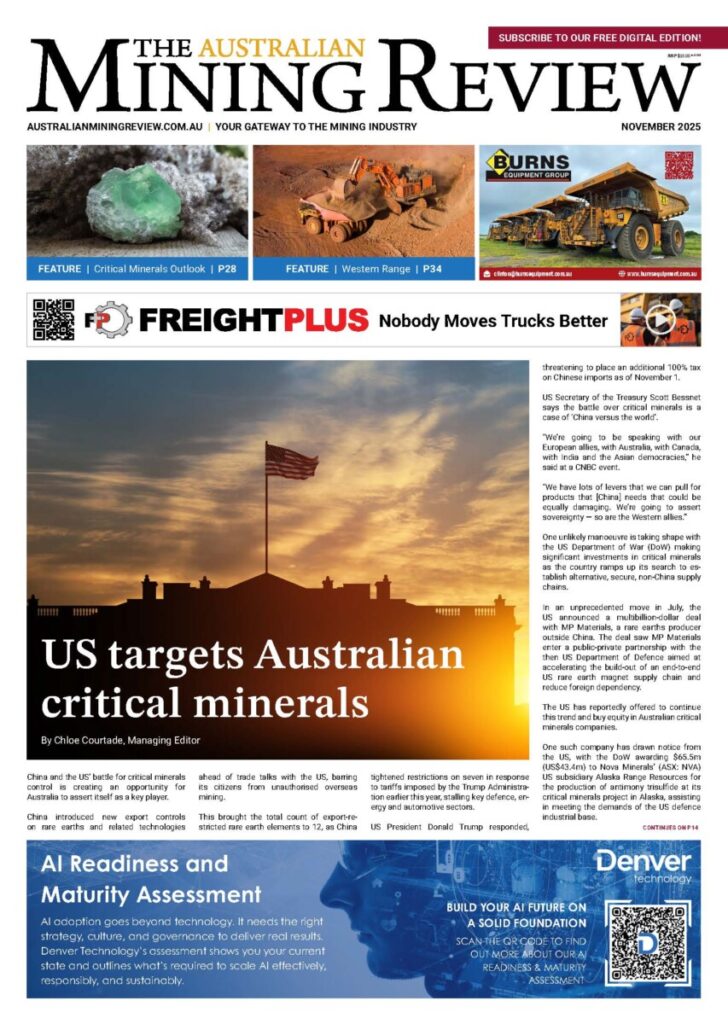Asserting Australia’s iron ore supremacy

Australian iron ore is almost indispensable for the global steel industry.
With the Pilbara’s unmatched high-quality, low-cost resources, Australia has dominated the global market since the rapid industrialisation of China in the early 2000s.
WA is the largest iron ore supplier in the world and, according to Geoscience Australia, generates about 99% of Australia’s total production.
In FY25, exports from the region totalled 775.7mt and accounted for $153b in revenue with Pilbara Ports handling 81% of Australia’s iron ore trade and 43% of global iron ore trade.
This massive industry has been developed across more than six-decades on the back of painstaking exploration, major investment and the development resources previously thought unsaleable.
The result — the Pilbara has become the most renowned name in the iron ore industry.
The Pilbara: iron ore’s crown jewel
On November 24, 1960, the Federal Government agreed to the partial lifting of an iron ore export ban that had been in place in Australia since 1938, heralding in a new era for the Australian iron ore industry.
Combined with the industrialisation of Japan in the 1960s, iron ore developers and geologists were incentivised to explore the remote Pilbara region of WA due to its strategic location proximal to major Asian markets.
Iron ore production in the Pilbara grew exponentially, reaching more than 100mtpa by the 1980s. The development of Taiwan and South Korea in the 1970s and 1980s further drove exports to more than 200mtpa by the early 2000s.
The industrialisation of China initiated the Pilbara’s major 21st century mining boom, increasing Australian exports to more than 800mtpa by 2016.
Australian producers were quick to capitalise on the rapid increase in Chinese demand, overtaking Brazil as the largest iron ore exporting country in 2007 — a previously unrivalled title.
The Australian industry developed at an unprecedented speed, growing almost fourfold during the period 2002-2018, while Brazilian exports increased about 160%.
During this period, more than $140b [US$93b] was invested in Pilbara iron ore projects, with two major new producers — Fortescue Metals Group (ASX: FMG) and Hancock Prospecting’s Roy Hill — emerging, complete with their own mine, rail and port infrastructure.
The Pilbara today is home to a vast network of mines, heavy haul rail and port infrastructure.
Global market dynamics
Due to the strong domestic demand for steel, underpinned by rapid industrialisation and infrastructure growth, China remains the world’s largest steel producer and consumer. According to the Reserve Bank of Australia, favourable government policies, significant government investment and the relocation of global steel production to developing countries, like China, have contributed to the country’s market dominance.
According to the Minerals Council of Australia (MCA), Japan still represents the world’s second largest market and Asia as a whole accounts for about 82% of total global seaborne imports, a major advantage for Australian producers due to the market proximity.
Over the last 40 years, closed-door negotiations between the small handful of miners and steelmakers, which dominate both spot and contract markets, have determined iron ore prices. Prices were determined in annual benchmark negotiations between the leading iron ore producers and importers until 2006 when Chinese company Baosteel began handling negotiations.
China has long been trying to control market fluctuations. In 2009, in talks with Beijing, BHP’s then chief executive Marius Kloppers, relinquished the fixed-price system in favour of fluctuating market pricing, as proposed by China, with prices at the time slumping as low as $118/t [US$78/t].
Vale and Rio Tinto (ASX: RIO) followed closely behind BHP and, in 2010, also broke the tradition of annual benchmark pricing for index-based quarterly pricing.
Less than two years later however, China’s push backfired as pricing rebounded to $245/t [US$170/t], a major win for Australian producers. BHP had completely shifted the market dynamic and China was left to the whims of volatile pricing.
In response to climbing iron ore prices, the Chinese Government established CMRG in 2022 to act as intermediary and centralise iron ore purchasing to improve China’s pricing power in the global market — reverting to private contract negotiations.
With Chinese demand expected to decline over coming years, ore prices are also expected to take a hit — creating a new hurdle for Australia’s most lucrative export industry.
South Flank: the future of Australian iron ore
Though Australia’s Pilbara miners have been pivotal to China’s rise to economic dominance, tensions between the stakeholders are tumultuous.
Despite this, Australia remains an undisputed global iron ore heavy weight. With an estimated 70bt of JORC compliant resources remaining on a 62% iron basis, Australia is expected sustain production for decades to come, according to the MCA.
Pilbara producers have the largest proportion of high-grade iron, low-cost DSO hematite, one of the key reasons Australia has become the world’s largest iron ore producer. Though some major producers are nearing their end of life, like BHP’s Yandi iron ore mine in WA, there are still substantial resources yet to be exploited.
BHP’s South Flank is Australia’s largest new iron ore mine in more than 50 years and is one of the largest in the world. Located at Mining Area C, 156km north-west of Newman, the South Flank iron ore mine is a $4.5b development.
With a production capacity of 80mtpa, South Flank is set bridge the gap left by legacy mines closing or winding down due to ore depletion, including the ageing Yandi mine. Together with Mining Area C, it will form the largest operating iron ore hub in the world producing 145mt of iron ore each year.
Integrating the latest advances in autonomous-ready fleets, digital connectivity and modular design, South Flank is setting new standards for the future of the resources industry.
The project commenced in July 2018 before achieving first ore in May 2021. South Flank exceeded its nameplate capacity of 80mt in its first full year of operations and is expected to supply global steel markets for 25 years.
South Flank is transforming the Pilbara’s iron ore landscape. It has quickly become BHP’s breadwinning asset, underpinning the company’s WA Iron Ore (WAIO) operations unprecedented third consecutive year of record production for FY25.
State-of-the-art infrastructure and innovative technologies have facilitated South Flank in overcoming commissioning challenges, allowing it to rapidly ramp-up to full production capacity.
In October, BHP confirmed a shift in its iron ore operations to focus on operational efficiency and cost control in the face of market volatility — and South Flank is the pinnacle.
Despite the Pilbara’s vast resource base and established infrastructure, there are some challenges that will shape the future of Australian iron ore production. A more competitive global market environment is evolving as new suppliers emerge, but Australian producers are well placed to continue to prosper in this situation.
As a wave of new iron ore mines outside of Australia bring fresh competition, namely the Simandou project in Guinea, Africa, concerns over the Pilbara’s supremacy have arisen.
Though dubbed the ‘Pilbara killer’, Simandou has a peak production capacity of 120mtpa — 25mt less than BHP’s South Flank and Mining Area C operations alone. Australia is projected to export about 905mt of iron ore this year with Africa expected to reach a massively smaller figure of 93mt, according to the Federal Industry, Science and Resources Department (DFISR).
Even backed by Simandou’s full capacity production, Africa is predicted to export less than 250mt of iron ore annually. Notwithstanding its significant resource, Simandou is unlikely to dethrone the Pilbara as the world’s leading producer. However, how it will shape the iron ore market is yet to be determined.
DFISR expects production at Simandou to underpin a 60% rise in iron ore export volumes from Africa between 2024 and 2027. However, geopolitical instability and environmental, social and governance (ESG) challenges may hinder Simandou’s ability to reach its full potential.
Amid the global race to net-zero, focus on greenhouse gas emissions has increased and steel mills are shifting the way they approach production. This is affecting market dynamics as steel mills are increasingly seeking higher grade, reflecting in the relative product pricing between ore quality categories.
South Flank and other Pilbara based operations have a clear advantage — geographical proximity to consumers, established export infrastructure, high quality ore and rigorous ESG compliance.
There is also opportunity to further increase production and reduce costs through increased process and supply chain optimisation and automation — areas in which the Pilbara is already considered an industry benchmark.
The extensive resources and infrastructure network, combined with world leading mining skills and workforce, has operations in the Pilbara, like South Flank, positioned to continue to dominate the global iron ore market.




